[Checklist] Local Social Media Marketing: How to Kill It
How can my business kill it at local social media marketing? Man, if I had a nickel for every time I was asked that.
How many times have you talked to a local small business owner (or employee of a small business) and, well, tell me if this scenario sounds familiar: Person A is on board with the idea of social media marketing, but are missing one of the wheels on their social-media-mobile in order to make it ride off into the success sunset.
Note: If you're here for the checklist, scroll to the bottom 🙂
Your Social Media Marketing Mobile Needs All Four Wheels
 This person, Person A, has a general destination in mind, let’s say New York, but no plans (or directions) of how to get there.
This person, Person A, has a general destination in mind, let’s say New York, but no plans (or directions) of how to get there.
It’s like driving around in a car with no idea where you are going or what you want to do when you get there, but,you expect that since you are driving, you will end up where you want.
That somehow, miraculously, you will arrive at your desired location, even though you never planned your route or followed any type of directional device (including asking someone for directions).
This way of thinking, “Well, everyone else is driving around somewhere so I should drive around too. Maybe if I drive around I will get where I need to go, eventually.” Seems a little backwards, right?
Successful Local Social Media Marketing Requires a Strategy
I have had countless conversations with friends or acquaintances that lack a general understanding of any social media marketing strategy. Social media often isn’t thought of as the mighty tool or technique that it really is because the majority of folks out there use it for leisure time web surfing.
A business may be getting likes or clicks and then wondering why these likes and clicks aren’t turning into visits or sales. They may even wonder why one social media platform worked well for them in one market or location, but no longer works. Not understanding how anything works and expecting favorable results, namely profit, is just not realistic.
Local Social Media Marketing Is More than Just Expecting Profit
Whenever I talk to people about local social media marketing and they do not understand all of the steps but expect their social media actions to magically turn into visitors or profit, I am reminded of an episode of South Park titled “Gnomes.”
These Gnomes stole items and then sold them for profit. When asked how they actually sold the items or what they did with them, none of the gnomes had any recollection. I get that South Park can be controversial, but what I’m referring to here is the general concept: the gnomes just knew that:
- Phase 1: collect said item
- Phase 2:? (no one knew)
- Phase 3: profit

Local Social Media Has a Phase Two
What’s the connection here? Well, this is exactly how I see many business owners approaching social media:
- Phase 1: post on social media
- Phase 2: ?
- Phase 3: profit
I do admit that the gnomes are a special case, and that their secret to success and not knowing how their business works worked for them, but rarely does that happen in real life! There is a whole lot of competition on social media for local businesses, especially the big brand stores and ecommerce sites or e-tailers.
It is hard to compete through social media channels when many larger businesses have more brand recognition, as well as dedicated employees developing a social media marketing strategy. More times than not in business, the one with a strategy or a method usually reaches better results than the one just winging it with no rhyme or reason.
Social Media Marketing vs. Local Social Media Marketing
What’s the difference between social media marketing and local social media marketing? Really, the difference between the two is the “local” part of it.
Social media marketing encompasses social media marketing in general (which can also include local customers), whereas local social media marketing encompasses targeting local social media fans, followers and potential customers specifically.
In other words, local social media marketing for business is the act of targeting and engaging consumers in a local geographic area on social media.
Local Social Media Popularity Can Vary by Platform
One major distinction of local social media marketing compared to social media marketing in general is knowing which social media platforms are used locally amongst your local consumers.
For example, in some regions Twitter is used almost religiously, and seldom in others. It doesn’t make sense then, for a local business to waste time posting on it if their consumers are not even using that platform.
Creating a Large Local Social Media Plan isn’t the Reality
Who has time for that? My local business clients don’t have time for creating a whole social media marketing plan! I get it. However, this isn’t all bad news for local businesses. Working with agencies and local media companies, they can get digital agency services from them, or agencies and media companies can give local businesses some great resources, ahem, to kill it at local social media marketing if they decide to manage social media in-house.
Use Your Locality to Your Advantage
The biggest weapon or advantage that a local business has that large businesses cannot as easily replicate is catering to the local market. Local businesses can offer a level of value through expertise and customer service that the larger, often low cost leaders cannot.
For the mid to larger size businesses, we aren’t discriminating—finding a way to cater to the local markets in which you serve is indeed possible, but harder to do if you are a multi-location or multinational entity.
TL;DR How to Win At Local Social Media:
Part A: Create A Local Social Media Marketing Strategy
1) Create a plan. Determine your business’s social media marketing purpose.
2) Know who you want to reach on social media.
3) Know which social media channels your personas use.
4) Clean up or create your business profile on your chosen social media channels.
5) Find out the best time and how often to post on each social media platform.
6) Determine how you can communicate your brand through social media.
7) Integrate/cross-promote social media efforts with your other marketing channels.
8) Create a social media content calendar.
9) Determine your tracking metrics based on your major social media marketing objectives.
10) Determine your measurable social media marketing goals
11) Determine where you will keep track of your social media marketing tracking data.
Part B: Posting Your Local Social Media Marketing Efforts
1) Provide information that users want to read.
Rule of thumb: 80% useful information (post information relevant to consumers problems and needs) and 20% promotional.
2) Post information useful and relevant to your target buyer persona.
3) Post often as determined by your buyer persona research.
4) Use quality images and photos. Just say no to cheesy stock photos.
Part C: Localize Your Social Media Marketing Efforts
1) Communicate to your customers about local store events.
2) Use local lingo and hashtags (where appropriate).
3) Allow and promote check-ins.
Part D: Personalize Your Local Social Media Marketing
1) Connect and converse with customers (this includes responding to reviews).
2) Shed some light on the faces behind the company.
3) Make social media fans feel special.
Part E: Advertise Your Local Social Media Marketing Efforts
1) Utilize paid ads and targeting on special content.
2) Try boosting special posts.
Part F: Review and Adjust Your Local Social Media Marketing Efforts
1) Review your performance from your tracking efforts.
2) Adjust and readjust your strategy.
Bonus: Social Media Posting Checklist
The Local Social Media Marketing Win List:
Part A: Create A Local Social Media Marketing Strategy
1) Create a plan. Determine your business’s local social media marketing purpose
Do not just post any old thing just to be on social media. Determine the goals you want to achieve from your local social media marketing efforts. Likes and other engagement may not result in a visit, but will keep your business top of mind and create brand awareness.
Think of All of the Stages of Your Buyer's Journey
Businesses that have a direct link to a product being sold online have a better chance of creating straight conversions (sales) through social media than a business hoping to attract visitors to their brick and mortar store. Brand awareness and customer relationship building may be more appropriate social media marketing goals.

For stores trying to bring business directly to their physical location, building brand awareness and consumer relationships is essential, so that when the consumer does need something, they will come to you. In other words, social media marketing will eventually drive demand. If driving demand to your business is your primary goal from your local social media marketing efforts, be aware that it will take time to take consumers through the buyer journey to the decision stage in which they will be ready to buy.
The above diagram illustrates objects common objectives and where they relate to in the buyer journey or sales funnel process:
Deeper Dive:
2) Know who you want to reach on social media
Get to know who your local customers are and what they are looking for online (buyer personas). Creating buyer personas and consumer profiles is more than just demographics.
Yes, you know your customers are ages X-Y and have Z number of children… but why do they shop at your store vs. the competitor? What problems are they facing that you can (or do) provide the solution to help them?
Seeing as though you are a local company, it should be easier to nail down who exactly your buyer personas are.
Psychographics Are The Shiny Gems on Your Persona Crown
Basic demographics give only a starting point of the really valuable target market information. You probably have more than one customer persona, more likely a primary persona who is your primary target market, and then you may have few secondary personas. Some of your local social media posts may hit one persona, or it may hit all of them.
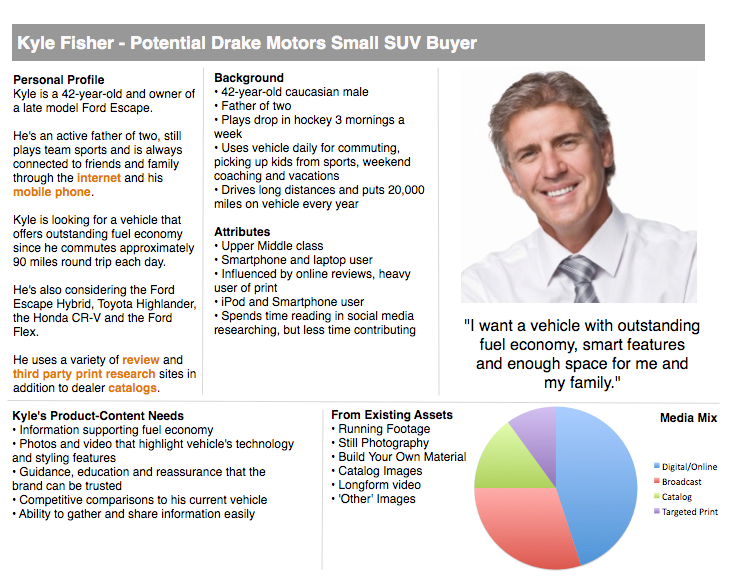
It is important to keeping in mind who you are talking to and why you are talking to them. The above example is a B2C consumer profile that hits a nice mix of attributes. Your business may want to add or change sections as you go along and get to know your consumers better.
Deeper Dive:
- Building an Epic Buyer Persona Profile a Totally Comprehensive Guide
- 3 Psychographic Gems You MUST Find Out About Your Customers
3) Know which social media channels your personas use
Determine which social media channels make the most sense to post on based on your buyer personas. If your customers don’t typically use that social media platform in your local area or region, then don’t waste your time posting on it. What’s the point of attracting non-local customers if you are a local business?

If your business doesn’t have the manpower necessary to man five social media channels, even if most are automated, make sure you know what you are getting into. If you do miss a popular social media channel, take the opportunity to create an account on there later. First, get good at the major ones your personas are on before trying to learn and get familiar with/master five channels at once.
Deeper Dive:
4) Clean up or create your business profile on your chosen social media channels
You may have already created a few social media accounts for your local business. Now is the time for you to update all of the information and add information in any areas you may have missed. It’s time to get your social media profiles ready to be lean mean local social media posting machines 😉
Pro tip: Make sure you keep track of your log-ins and passwords and authorize any users the appropriate levels of access that will have access to the business account for that social media profile.
Deeper Dive:
5) Find out the best time and how often to post on each social media platform
Determine when your local buyer personas are most likely on certain social media profiles and plan to post at these times. This may be the same for all of them, but it may not. The moral of the story here is while it would be great to post whenever works for you, your readers may not ever see it.
Local Social Users May Have Different Peak Usage Times
Let’s say that Instagram users typically only read their posts after 5:00 p.m. when they get home from work. But, for your local personal, maybe traffic is bad in your local area and while users get off of work at 5:00 p.m., they don’t actually get home to veg out on social media until 6:00 p.m.

While there are many resources out there that speak to the masses, make sure that they indeed make sense for your local market. Since social media posts can get buried very quickly, you want to make sure you hit them at the right time on their feeds. The cat arm above depicts the best times to post in general on different social media platforms.
Deeper Dive:
6) Determine how you can communicate your brand through local social media
What makes your company unique and gives it its own unique personality through social media? If your company is funny, then use (tasteful) humor in your posts.


As a rule, use social media to be an extension of your brand, to connect with customers in a personable way. For example, maybe in your local area there are specific tasteful jokes you can play on, use what you got!
Deeper Dive:
7) Integrate/cross-promote social media efforts with your other marketing channels
Give exposure to your local social media account by integrating it with your other marketing and communications efforts. For instance, you can add social media buttons to the footers of your emails and newsletters, on your blog, etc. What better way to educate the consumers in your different channels than to give them even more chances to stay connected to your business?!

If you want to stay on top of the local scene, create social groups and moderate them, even post your content on there periodically (let others post too and don’t make it overly obvious that it’s your forum for self-promotion). Look for different ways that you can tap into the local market that perhaps your larger competitors cannot.
Deeper Dive:
8) Create a social media content calendar
Once you have an idea of who you are posting to, why you are posting to them, how you are posting to them and when you are posting to them, a social media content calendar is a great way to keep your sanity in check.

Above is an example of a content calendar template a business can make in a spreadsheet program.
If you have a blog and create landing pages, a great strategy is to create useful blog posts and drive traffic and promote your content through your social media channels. This way, you are bringing consumers to your website to read the content and they can easily like and share your content via social media. Not only are you getting contact information on potential interested consumers, they are also promoting your business by sharing your content - for free!
Deeper Dive:
9) Determine your tracking metrics based on your major social media marketing objectives
In order to see how your goals are measuring up, you must track them. Determine which metrics you would like to use. While some of the obvious ones are likes and shares, make sure you don’t forget conversion and revenue metrics.
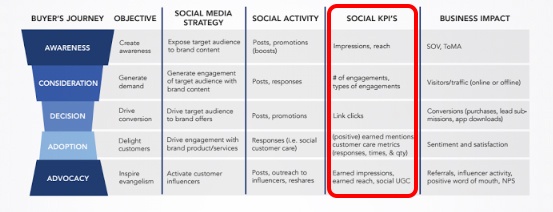
The table shown above highlights the most impactful metrics to track at each customer awareness stage that coincides with typical social media goals at each stage. Each social media platform in particular has unique metrics or KPI’s that you can deem useful for your business over time.
Deeper Dive:
10) Determine your measurable local social media marketing goals
Now that you have an idea of your purpose for being on social media, where you want to post, how often you want to post, and what metrics you want to track, its a good idea to start setting some targets and goals that you want to reach.
Generally speaking, you may need to go back and forth between this stage and your content calendar after a few posts to determine whether you have enough content or even too much based on your initial goals.
Local Social Media Marketing Goals Need to be SMART
The following is a simple but illustrative example of how to start framing your goals and strategy. Notice that there are some SMART (specific, measurable, attainable, rewarding and timely) goals listed in the example below.

This may seem like a lot of work, but trust me, once you get in the hang of it and get all set up, you will be a local social media pro in no time!
Deeper Dive:
11) Determine where you will keep track of your social media marketing tracking data
So now you know what you want to achieve from your local social media marketing efforts and how you want to achieve it, but where do you keep track of all of that data? Depending on the size of your goals and metrics, you can start by keeping track of your data in a spreadsheet.
Below is a great template that not only the measures the basic KPIs (key performance indicator), but helps determine based on your metrics different calculations for effectiveness.
Develop Your Own Stats or Calculations Over Time
Creating your own spreadsheet or using a template should suffice if/when you feel you have gotten to a point where you would rather use a dashboard or automate your social media marketing efforts more.
The examples below are a fantastic start and break down teach segment of the sales funnel by tabs with calculations such as conversion relevance, average potential reach per activity and network activity. Over time you will develop stats or calculations that make the most sense for you based on your social media marketing goals.


Data Tracking is Worth the Effort
If you aren’t a numbers person, don’t fret. Yes tracking numbers is extra work, but it is worth it for your business to determine which social media efforts are proving the most useful, where you can improve, and the list goes on.
However, do not just track likes and call it a day though, that will not tell you all that you need to know about your social media efforts unless your goal is just to generate brand awareness.
Deeper Dive:
Part B: It’s Go Time! Posting Your Local Social Media Marketing Efforts
1) Provide information that users want to read
Remember that your local fans and followers want to keep in touch with your brand, not be inundated with advertising. Do not just use social media to advertise products and say how great your business is. Things have changed in the marketing world of today, and consumers want relevant, useful information to help them with the everyday problems that they are facing.

Tweet this: Rule of thumb: 80% useful information (relevant to consumers problems & needs) & 20% promotional.
Therefore, constantly being advertised to is not something that people want to see anymore. In fact, it’s kind of taboo. Would you follow a company on social media that was constantly just promoting themselves? Nowadays that’s like trying to have a conversation with a person that always talks about themselves. Snore.
Deeper Dive:
2) Post information useful and relevant to your target buyer persona
Am I repeating myself? Yes. But I’m hoping to get my point across here. Post information on your social media channels that will grab the audience’s attention and is so great and useful that they want to share with friends.
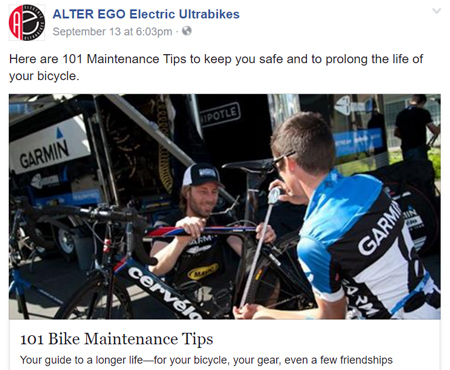
Suppose you own a bike shop. Your personas are competitive cyclists and avid cyclists. Your avid cyclists now have families. Posting an article on your blog about tips for buying a bicycle for your growing child may be shared more than a promotional post about your newest bikes.
Chances are that avid cyclist has avid cyclist friends on that social media channel that will see that post. Or in the example above, some bike maintenance tips for those avid cyclists.
3) Post often as determined by your buyer persona research
Once your business determines how often you want to post, keep posting consistently. If your business is posting consistently for a while and then stops posting on social media suddenly, consumers may think that you business has gone out of business and is no longer a going concern.
This stresses the point that when strategizing which social media channels your business will adopt, only take on what your business can chew.
4) Use quality images and photos. Just say no to cheesy stock photos
On some social media platforms, statuses with photos are served more to fans of the business than text only posts. Not only that, are you yourself more likely to notice a post if it has just text or a relevant and interesting image? That being said, please stay away from cheesy stock photos.

If possible, take your own quality photos of your business, employees and customers (if they agree to be shown). If you need to use stock photos, there are plenty of sites with good quality, free stock photos—just choose wisely.
Deeper Dive:
Part C: Localize Your Social Media Marketing Efforts
1) Communicate to your customers about local store events
Keep in touch about events and happenings with your local business. This type of promoting allows fans and followers know about something that is happening with your business that they may want to know about.

Maybe your business is at a local trade show or charity event—this is a great time to tell them to come and visit you or inform them of the causes your business supports or is involved with.
Deeper Dive:
2) Use local lingo and hashtags (where appropriate)
Where possible, use hashtags and appropriate lingo that your local customer would know and appreciate. Where I originally hail from there is a definite lingo that is the epitome of local. As a matter of fact, one sign really spoke to local customers, online and offline.

Though this sign wouldn’t make sense in most cities, in the place I’m from, “poor deal anyways” is an inside joke—one that McDonald’s is in on.
Exception to the rule: avoid the social media marketing fail of hashtag jacking, especially when it comes to a sensitive subject or issue.
3) Allow and promote check-ins
When setting up profiles on the social media platforms of your choosing, ensure that you allow check-ins if the social media platforms allow. When users check-in to your business, it will show up on the timelines of all of their connections and really, you can’t beat free advertising.
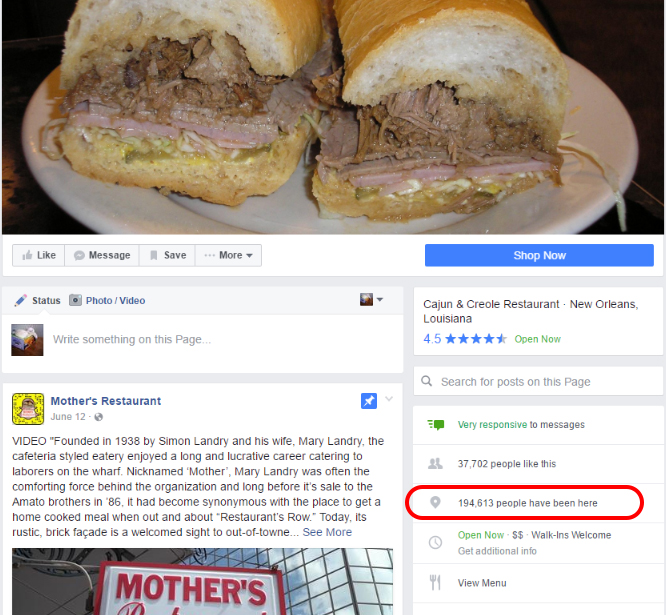
Deeper Dive:
Part D: Personalize Your Social Media Marketing Efforts
1) Connect and converse with customers (this includes responding to reviews)
So maybe your fans or followers aren’t customers yet but they have questions for you and they are asking you on social media.
Thus it may take a bit of time to respond to them, but you are building trust. If that customer doesn’t end up purchasing from you, you don’t know who saw your answers on social media and has gained your trust from reading that post.

Compared to many big chain stores, local stores are often the go-to for consumers that want to know information about their products and services from an expert. Consequently, local businesses have the opportunity to shine in customer service where many big companies are known to fall short in that area.
2) Shed some light on the faces behind the company
Let viewers see the faces behind the company, as it humanizes the business and it is not seen as a faceless entity.
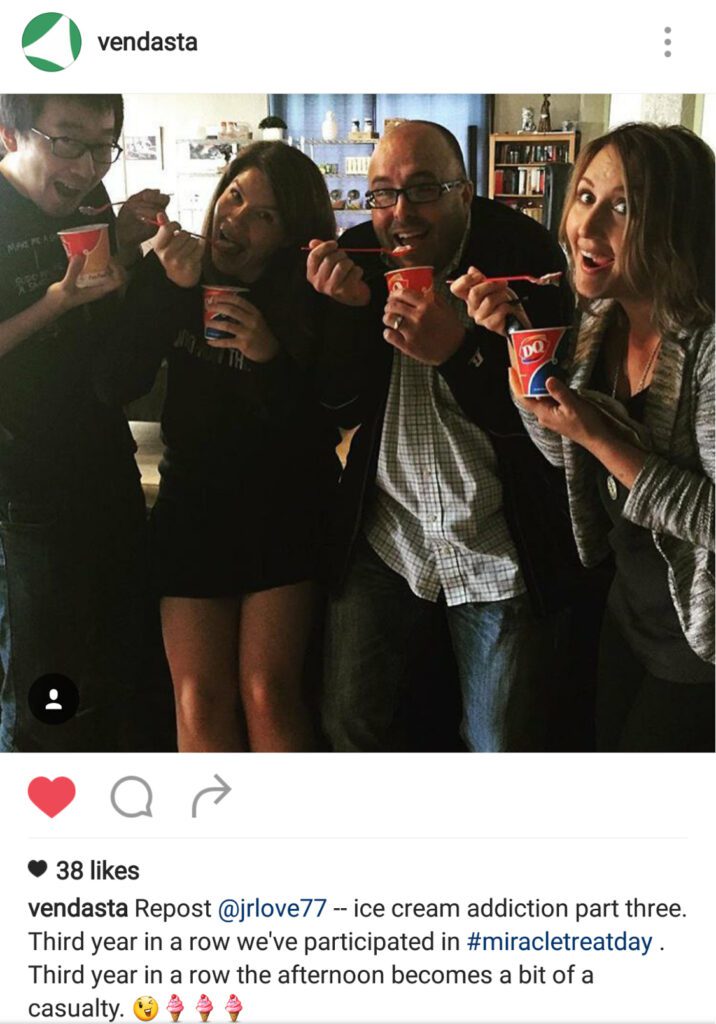
3) Make social media fans feel special
Include exclusive discounts or offers for social media fans.

Deeper Dive:
Part E: Advertise Your Local Social Media Marketing Efforts
1) Utilize paid ads and targeting on special content
If you want to reach local customers through your social media marketing efforts, you can try hyperlocal options and specific demographics based on your consumer persona investigation. Educate yourself on how much you are paying for ads and all of the advertising options on the various social media channels.

Deeper Dive:
2) Try boosting special posts
This step in particular is Facebook specific. Facebook now has targeting tools for boosted posts that allow businesses to target an email list of people. Consequently, this tactic can ensure that a list of your most important customers are seeing your important posts.

Deeper Dive:
Part F: Review and Adjust Your Local Social Media Marketing Efforts
1) Review your performance from your tracking efforts
Now is a good time to go back and take a look at all of the different measurements you tracked and see how close you are to hitting your goals. It will take some practice to start seeing what types of actions results in what types of performance.
2) Adjust and readjust your local social media marketing strategy
Last but not least, adjust and readjust your strategy. Chances are you are not hitting exactly every metric you are wanting to hit off of the bat. If you are hitting all of your goals off of the hop, you are probably setting your goals too low!
This is the stage where you can go back and look at all the parts of your strategy in part one and adjust as you see fit. It’s just like modifying a recipe the next time you make it to get it just right.
The Ultimate Social Media Marketing Checklist
Over the years I have written many business plans, marketing plans and you guessed it, the full social media marketing plan. As much as I love writing and would recommend planning every thought and step out and documenting it in a plan, the reality is that most businesses do not have the time to do so. If you do want to write a full social media plan, that is great and I urge every business to do so. Use this post as a framework for constructing your social media plan whether it be local, nation-wide or global in scope.
But if you do not, we have crafted a three page social media posting checklist that will help businesses remain cognizant of their social media marketing plans and strategic purpose in each social post. For your reading pleasure, the infographic version is displayed below.


